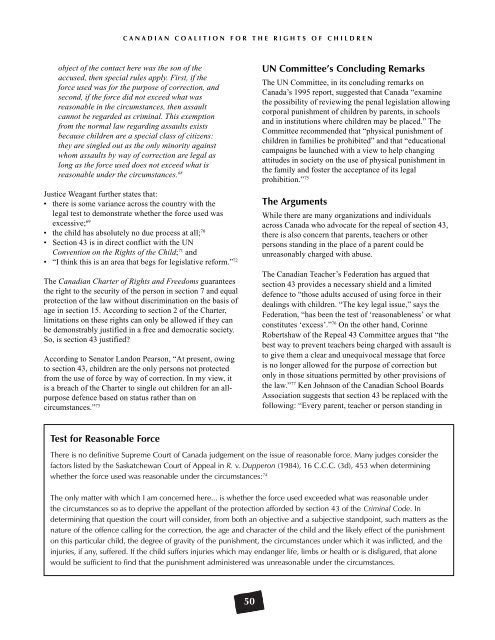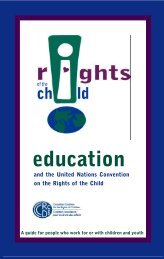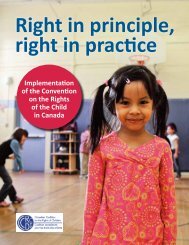Poste - Canadian Coalition for the Rights of Children
Poste - Canadian Coalition for the Rights of Children
Poste - Canadian Coalition for the Rights of Children
Create successful ePaper yourself
Turn your PDF publications into a flip-book with our unique Google optimized e-Paper software.
C A N A D I A N C O A L I T I O N F O R T H E R I G H T S O F C H I L D R E N<br />
object <strong>of</strong> <strong>the</strong> contact here was <strong>the</strong> son <strong>of</strong> <strong>the</strong><br />
accused, <strong>the</strong>n special rules apply. First, if <strong>the</strong><br />
<strong>for</strong>ce used was <strong>for</strong> <strong>the</strong> purpose <strong>of</strong> correction, and<br />
second, if <strong>the</strong> <strong>for</strong>ce did not exceed what was<br />
reasonable in <strong>the</strong> circumstances, <strong>the</strong>n assault<br />
cannot be regarded as criminal. This exemption<br />
from <strong>the</strong> normal law regarding assaults exists<br />
because children are a special class <strong>of</strong> citizens:<br />
<strong>the</strong>y are singled out as <strong>the</strong> only minority against<br />
whom assaults by way <strong>of</strong> correction are legal as<br />
long as <strong>the</strong> <strong>for</strong>ce used does not exceed what is<br />
reasonable under <strong>the</strong> circumstances. 68<br />
Justice Weagant fur<strong>the</strong>r states that:<br />
• <strong>the</strong>re is some variance across <strong>the</strong> country with <strong>the</strong><br />
legal test to demonstrate whe<strong>the</strong>r <strong>the</strong> <strong>for</strong>ce used was<br />
excessive; 69<br />
• <strong>the</strong> child has absolutely no due process at all; 70<br />
• Section 43 is in direct conflict with <strong>the</strong> UN<br />
Convention on <strong>the</strong> <strong>Rights</strong> <strong>of</strong> <strong>the</strong> Child; 71 and<br />
• “I think this is an area that begs <strong>for</strong> legislative re<strong>for</strong>m.” 72<br />
The <strong>Canadian</strong> Charter <strong>of</strong> <strong>Rights</strong> and Freedoms guarantees<br />
<strong>the</strong> right to <strong>the</strong> security <strong>of</strong> <strong>the</strong> person in section 7 and equal<br />
protection <strong>of</strong> <strong>the</strong> law without discrimination on <strong>the</strong> basis <strong>of</strong><br />
age in section 15. According to section 2 <strong>of</strong> <strong>the</strong> Charter,<br />
limitations on <strong>the</strong>se rights can only be allowed if <strong>the</strong>y can<br />
be demonstrably justified in a free and democratic society.<br />
So, is section 43 justified?<br />
According to Senator Landon Pearson, “At present, owing<br />
to section 43, children are <strong>the</strong> only persons not protected<br />
from <strong>the</strong> use <strong>of</strong> <strong>for</strong>ce by way <strong>of</strong> correction. In my view, it<br />
is a breach <strong>of</strong> <strong>the</strong> Charter to single out children <strong>for</strong> an allpurpose<br />
defence based on status ra<strong>the</strong>r than on<br />
circumstances.” 73<br />
Test <strong>for</strong> Reasonable Force<br />
50<br />
UN Committee’s Concluding Remarks<br />
The UN Committee, in its concluding remarks on<br />
Canada’s 1995 report, suggested that Canada “examine<br />
<strong>the</strong> possibility <strong>of</strong> reviewing <strong>the</strong> penal legislation allowing<br />
corporal punishment <strong>of</strong> children by parents, in schools<br />
and in institutions where children may be placed.” The<br />
Committee recommended that “physical punishment <strong>of</strong><br />
children in families be prohibited” and that “educational<br />
campaigns be launched with a view to help changing<br />
attitudes in society on <strong>the</strong> use <strong>of</strong> physical punishment in<br />
<strong>the</strong> family and foster <strong>the</strong> acceptance <strong>of</strong> its legal<br />
prohibition.” 75<br />
The Arguments<br />
While <strong>the</strong>re are many organizations and individuals<br />
across Canada who advocate <strong>for</strong> <strong>the</strong> repeal <strong>of</strong> section 43,<br />
<strong>the</strong>re is also concern that parents, teachers or o<strong>the</strong>r<br />
persons standing in <strong>the</strong> place <strong>of</strong> a parent could be<br />
unreasonably charged with abuse.<br />
The <strong>Canadian</strong> Teacher’s Federation has argued that<br />
section 43 provides a necessary shield and a limited<br />
defence to “those adults accused <strong>of</strong> using <strong>for</strong>ce in <strong>the</strong>ir<br />
dealings with children. “The key legal issue,” says <strong>the</strong><br />
Federation, “has been <strong>the</strong> test <strong>of</strong> ‘reasonableness’ or what<br />
constitutes ‘excess’.” 76 On <strong>the</strong> o<strong>the</strong>r hand, Corinne<br />
Robertshaw <strong>of</strong> <strong>the</strong> Repeal 43 Committee argues that “<strong>the</strong><br />
best way to prevent teachers being charged with assault is<br />
to give <strong>the</strong>m a clear and unequivocal message that <strong>for</strong>ce<br />
is no longer allowed <strong>for</strong> <strong>the</strong> purpose <strong>of</strong> correction but<br />
only in those situations permitted by o<strong>the</strong>r provisions <strong>of</strong><br />
<strong>the</strong> law.” 77 Ken Johnson <strong>of</strong> <strong>the</strong> <strong>Canadian</strong> School Boards<br />
Association suggests that section 43 be replaced with <strong>the</strong><br />
following: “Every parent, teacher or person standing in<br />
There is no definitive Supreme Court <strong>of</strong> Canada judgement on <strong>the</strong> issue <strong>of</strong> reasonable <strong>for</strong>ce. Many judges consider <strong>the</strong><br />
factors listed by <strong>the</strong> Saskatchewan Court <strong>of</strong> Appeal in R. v. Dupperon (1984), 16 C.C.C. (3d), 453 when determining<br />
whe<strong>the</strong>r <strong>the</strong> <strong>for</strong>ce used was reasonable under <strong>the</strong> circumstances: 74<br />
The only matter with which I am concerned here... is whe<strong>the</strong>r <strong>the</strong> <strong>for</strong>ce used exceeded what was reasonable under<br />
<strong>the</strong> circumstances so as to deprive <strong>the</strong> appellant <strong>of</strong> <strong>the</strong> protection af<strong>for</strong>ded by section 43 <strong>of</strong> <strong>the</strong> Criminal Code. In<br />
determining that question <strong>the</strong> court will consider, from both an objective and a subjective standpoint, such matters as <strong>the</strong><br />
nature <strong>of</strong> <strong>the</strong> <strong>of</strong>fence calling <strong>for</strong> <strong>the</strong> correction, <strong>the</strong> age and character <strong>of</strong> <strong>the</strong> child and <strong>the</strong> likely effect <strong>of</strong> <strong>the</strong> punishment<br />
on this particular child, <strong>the</strong> degree <strong>of</strong> gravity <strong>of</strong> <strong>the</strong> punishment, <strong>the</strong> circumstances under which it was inflicted, and <strong>the</strong><br />
injuries, if any, suffered. If <strong>the</strong> child suffers injuries which may endanger life, limbs or health or is disfigured, that alone<br />
would be sufficient to find that <strong>the</strong> punishment administered was unreasonable under <strong>the</strong> circumstances.




